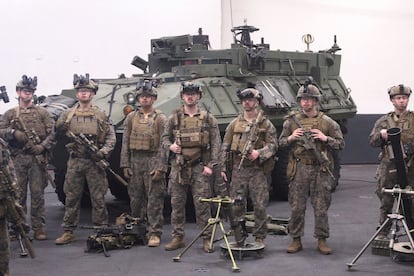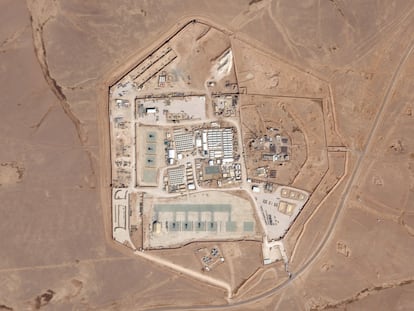US military deployment becomes Joe Biden’s weak point in the Middle East crisis
The president, who is trying to avoid escalation in a region where 30,000 U.S. troops are stationed, says he has already decided how to respond to the attack on a base in Jordan


President Joe Biden has stated he has decided how Washington will respond in the Middle East to Sunday’s drone attack, allegedly launched by pro-Iranian militias, which left three U.S. military personnel dead and 40 more wounded at an outpost in Jordan. The White House needs to calibrate its response very carefully at a time when the spotlight is already on its 30,000 military personnel in the region, amid a conflict that has extended beyond the war between Israel and Hamas and threatens to drag other powers into the arena.
Biden faces a problem that previous U.S. administrations have had to navigate during conflicts in the Middle East: how to respond forcefully enough to prevent more attacks, but not to the point of triggering an escalation of unpredictable consequences. The goal is to avoid moving from pockets of skirmishes between pro-Iranian militias and U.S. forces in Syria, Iraq, and the Red Sea to an apocalyptic scenario: a direct confrontation between the United States and Iran, which neither of the two old adversaries wants.
In brief remarks as he was leaving the White House to begin a trip to Florida, Biden declined to specify what his government’s response would be after spending Monday in meetings with his national security advisors. He did warn that he holds Iran — which denies direct involvement in the incident — responsible “in the sense that they’re supplying the weapons to the people who did it.” But, acknowledging his dilemma, he added: “I don’t think we need a wider war in the Middle East. That’s not what I’m looking for.”
Multiple actions
A few brushstrokes have already emerged. National Security Council spokesman John Kirby told reporters on Air Force One there will “not just a single action, but potentially multiple actions over a period of time.” This points to a retaliation similar to that undertaken against Houthi militias in Yemen, also backed by Iran, which have been attacking ships in the Red Sea. There, British and U.S. forces have bombed radar systems and missile arsenals belonging to the rebel groups. “The guiding principle is making sure that we continue to degrade the kinds of capabilities that these groups have at their disposal to use against our troops and our facilities,” Kirby added.
When any retaliation will occur is not yet clear. Among other considerations, it remains to be determined exactly which group was behind the strike on the U.S. Tower 22 base on the Jordan-Syria border, and how exactly the drone strike came about.
Last weekend’s strike was not unlike the dozens that U.S. forces have been targeted by since the Israel-Hamas war broke out on October 7. Washington, which maintains the bulk of its forces in the region at bases in the Persian Gulf, has 3,000 troops stationed in Jordan, one of its staunchest allies in the region. Also, as part of its fight against Islamic State, it maintains around 900 troops in Syria — particularly in Kurdish areas in the north — and 2,500 in Iraq, with whose government it is negotiating the future of this deployment. A good part of these troops are stationed in bases such as Tower 22, surveillance and logistics posts in remote locations that are very visible from the air.
The coalition of militias known as the Islamic Resistance in Iraq has carried out about 140 drone and missile attacks on U.S. forces’ positions. It has also claimed responsibility for Sunday’s attack, which included strikes on two other outposts, in which the incoming drones were shot down without incident. But the strike on Tower 22 was the first to cause U.S. casualties since the start of the Gaza conflict. According to early accounts, U.S. personnel mistook the drone for one of their own. On Wednesday, the U.S. attributed the attack to the Islamic Resistance in Iraq.
The White House has confirmed that Biden will on Friday receive the bodies of the three soldiers killed at Dover Air Force Base in Delaware. This is a position the president had hoped not to be in when in 2021 he officially declared the end of the U.S. combat mission in Iraq, two decades after the start of the war on terror declared by George W. Bush.
Instead, since the beginning of the conflict in Gaza, the United States has seen attacks on its forces multiply and has reinforced its military deployment in the region. In the eastern Mediterranean, the battle group led by the amphibious assault ship Bataan and manned by a detachment of 2,500 U.S. Marines, has a dual mission: to deter the pro-Iranian militia Hezbollah from attacking Israel, and to reinforce protection for merchant ships against Houthi attacks in the Red Sea. In those waters, the aircraft carrier USS Dwight D. Eisenhower and its strike group, with 5,000 military personnel on board, are carrying out a similar mission.
At the same time, U.S. diplomats are trying to push forward negotiations for a temporary ceasefire between Hamas and Israel, which they hope could be their best chance to stabilize the situation, at least relatively. The pact being negotiated in Paris, where the United States is represented by CIA Director William Burns, would include a two-month suspension of the war in exchange for the release of more than a hundred of the hostages still held in the Strip, in a more ambitious deal than the one that led to a week-long truce late last November.
“The hope is that a longer period of calm and stability could create the space for more diplomacy and set in motion the conditions for a longer understanding,” Brian Katulis, vice president of the Middle East Institute think tank in Washington, said in a note.
Progress in such negotiations “would be a strategic triumph for the United States and its allies in the region, and a blow to Iran and its allies, who have made great strides while the conflict has dragged on. As it considers its response to the deadly attack, the United States must keep its strategic plan and interests in mind, and design its actions to achieve those more worthy goals,” notes Paul Salem, president of the Middle East Institute.
Sign up for our weekly newsletter to get more English-language news coverage from EL PAÍS USA Edition
Tu suscripción se está usando en otro dispositivo
¿Quieres añadir otro usuario a tu suscripción?
Si continúas leyendo en este dispositivo, no se podrá leer en el otro.
FlechaTu suscripción se está usando en otro dispositivo y solo puedes acceder a EL PAÍS desde un dispositivo a la vez.
Si quieres compartir tu cuenta, cambia tu suscripción a la modalidad Premium, así podrás añadir otro usuario. Cada uno accederá con su propia cuenta de email, lo que os permitirá personalizar vuestra experiencia en EL PAÍS.
¿Tienes una suscripción de empresa? Accede aquí para contratar más cuentas.
En el caso de no saber quién está usando tu cuenta, te recomendamos cambiar tu contraseña aquí.
Si decides continuar compartiendo tu cuenta, este mensaje se mostrará en tu dispositivo y en el de la otra persona que está usando tu cuenta de forma indefinida, afectando a tu experiencia de lectura. Puedes consultar aquí los términos y condiciones de la suscripción digital.
More information
Archived In
Últimas noticias
Most viewed
- Reinhard Genzel, Nobel laureate in physics: ‘One-minute videos will never give you the truth’
- Oona Chaplin: ‘I told James Cameron that I was living in a treehouse and starting a permaculture project with a friend’
- Pablo Escobar’s hippos: A serious environmental problem, 40 years on
- Charles Dubouloz, mountaineering star, retires at 36 with a farewell tour inspired by Walter Bonatti
- Why we lost the habit of sleeping in two segments and how that changed our sense of time










































